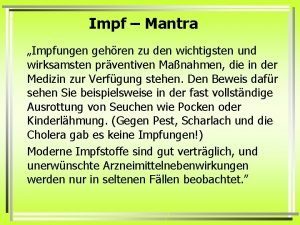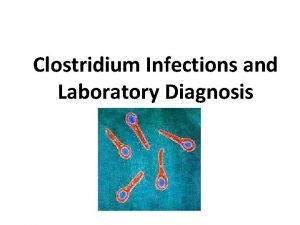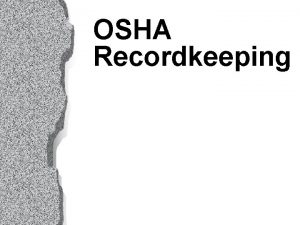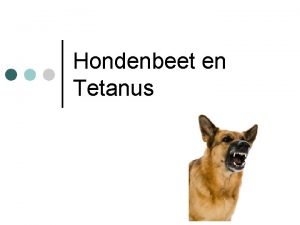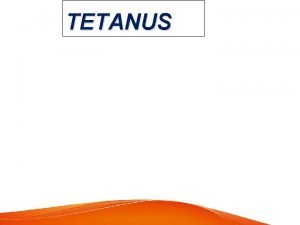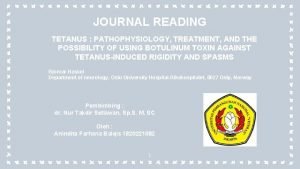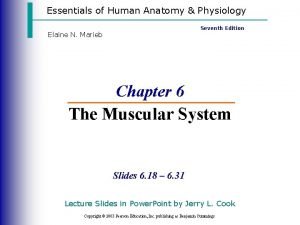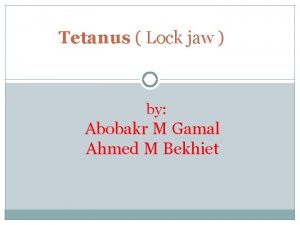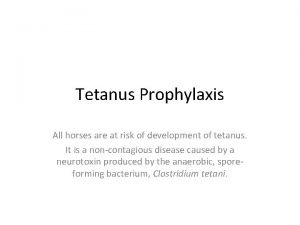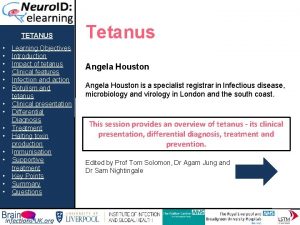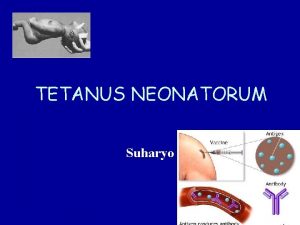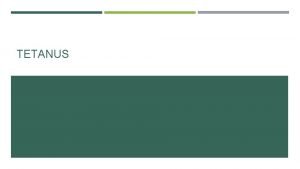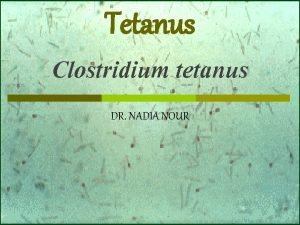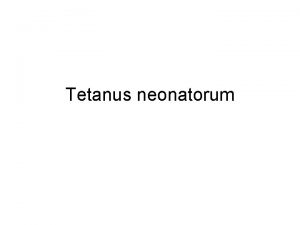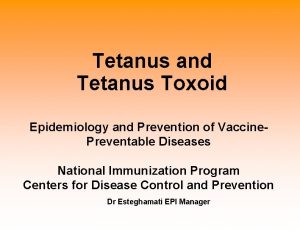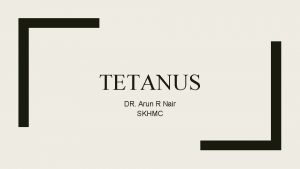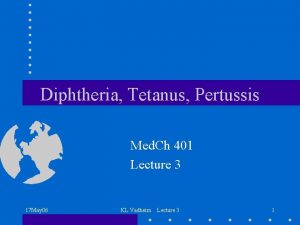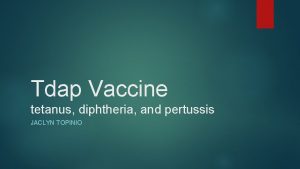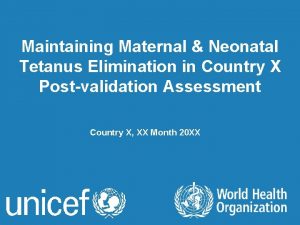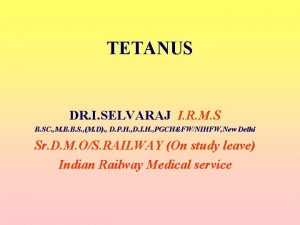1 2 3 4 5 6 7 TETANUS


















- Slides: 18

1. 2. 3. 4. 5. 6. 7. TETANUS TUBER CULOSIS CHOLERA TYPHOID LEPROSY PLAGUE ANTHROX

NAME OF THE MICROBE : Clostridium tetani MEDIA: Soil. DESCRIPTION These bacteria live in the intestine of the herbivorous animals. Spores of these bacteria get into the through their faeces. Then they enter the human body through the cut wounds.

SYMPTOMS: They develop after 2 -3 days. Initially head ache and fever appear. Because of spasm of muscles patient feels difficulty in opening the mouth and rigidity appears through out the body. The body bends like a bow and finally death may occur. TREATMENT: As soon one gets the injury, clean it with water thoroughly. Take antitetanus injection from a doctor.

PRECAUTIONS: It is very difficult control the disease after it sets in body. Therefore it is necessary to take the preventive measures. Avoid the use of rusted or dirty pin or needle to remove a thorn. Do not smear the wound with soil or cattle dung.

DISCRIPTION: Bacteria bacterium tuberculosis or tuberculosis bacilli enter the lungs through air. They grow in lungs and produce nodules. After the infection, it may take some weeks or months for the appearance of the symptoms. TREATMENT: It is important to control this disease in the initial phase only. For complete cure it needs a 1 year treatment.

SYMPTOMS Excessive fatigue, lack of appetite, slight raise in body temperature in the evening, night sweating, loss of weight are its symptoms. In the initial stages dry cough may be presents. If the treatment is not taken properly cough increases along with white or yellowish sputum in which blood may appear. Patient gets pain in the chest when coughing. PRECAUTIONS; B. C. G. (Bacillus Callmette Guerin) vaccine provides immunity against tuberculosis. The disease can be controlled by controlling air pollution and keeping the environment clean.

NAME OF THE MICROB: Vibrio cholera. MEDIA: Food and water. SYMPTOMS: The patient gets severe diarrhoea and vomiting with massive loss of water from the body within a few hours he becomes dehydrated eyes because sunken. Skin does not regain to its normal position after it is stretched.

TREATMENT: Oral re-hydration solution should be given and seek the advice of a doctor immediately. PRECAUTION: Preparation of oral re- hydration solution. Take a litre of a boiled and cooled water and to this add 2 spoons of sugar ¼ of spoon of sodium bicarbonate mix it properly. Ready made ORS is also avialable in primary health centers and in medical stores. As a precautionary measure always use. The boiled and cooled water. Do not eat the food which is spoilt or kept open. Maintain the cleanliness. Take cholera vaccine.

NAME OF THE MICROB: Salmonella typhi MEDIA: Insects and flies. DESCRIPTION: This is disease is caused by salmonella typhi. They enter the inner wall of intestine and produce cysts. These cysts enter the water or food through faeces of the infected person flies also spread this disease.

SYMPTOMS: Head ache is seen first and then fever keeps increasing but the pulse does not rise in accordance with the raising of body temperature some times diarrhea. Vomiting and constipation are seen. During the second weak rose coloured rashes are seen on the body. Body weight decreases due to weakness. TREATMENT: Wet cloth should be on the forehead and sponging should be done to reduce the fever. Patient needs complete rest juice and liquid food is suggested.

PRECAUTIONS: One should drink boiled and cooled water. Attention should be taken towards personal hygiene. Do not eat which are kept open and take vaccine for a disease.

NAME OF THE MICROB: Micro- bacterium leprae. MEDIA: Deformity of organs. DESCRIPTION: Deformity of organs such as fingers, toes, nose and ears occur. There are 2 types of leprosy; ØLepromatous ØTuber culoid.

NAME OF THE MICROB: Yerssinia Pertis. MEDIA: Insects, fleas. DESCRIPTION: It is primarily a disease of the rodents fleas after biting the diseased rat carry these microb. When they bite the healthy man, the spread of plague takes place during this period death of many rats occurs.

SYMPTOMS OF LEPROMATOUS : In lepromatous type white –red coloured patches are seen on the skin. Then tuber of different shape appear on the face. It is contagious. SYMPTOMS OF TUBER CULOID: This type of bacteria affect the nerves and cause the loss of sensation on the skin. Gradually the finger and toes get deformed and are lost. It is not contagious. TREATMENT: Leprosy can be cured by proper treatment.

SYMPTOMS: The plague resemble flue initially but with in 1 or 2 days the lymph nodes in the armpit and the neck enlarge. Some times through the respiratory Tract this bacteria enter the lungs causing very severe pneumonia. PRECAUTIONS: Populations of rats should be controlled and fleas should be destroyed to control and prevent the disease.

NAME OF THE MICROB: Bacillus Anthrocis. MEDIA: Affects the split hoofed. DESCRIPTION: It usually effects the split hoofed animals like cattle, sheep, goat, pig.

SYMPTOMS: The eye of the infected animal turns deep red and tears flow out from the eyes. The animals becomes inactive, suffers from fever. It finds it difficult to chew the cud. The abdomen distends due to constipation. All of a sudden it may fall to the ground and die. PRECAUTIONS: The bacteria can continue to remain alive in the skin and hair of the dead animals for years. Therefore, dead bodies of such animals must be burnt or buried in a deep pit away from water sources. The other animals must be immunized.

 Nesselsucht nach tetanusimpfung
Nesselsucht nach tetanusimpfung Difference between tetanus and tetany
Difference between tetanus and tetany Sarkolema
Sarkolema Charles bell tetanus
Charles bell tetanus Tetanus neonatorum ppt
Tetanus neonatorum ppt Fajar tetanua
Fajar tetanua Hondenbeet tetanus
Hondenbeet tetanus Osha log posting dates
Osha log posting dates Tetanusprofylaxe
Tetanusprofylaxe Vrbanac kod svinja liječenje
Vrbanac kod svinja liječenje Laatjevaccineren.be/tetanus-klem
Laatjevaccineren.be/tetanus-klem Tetanus
Tetanus Treppe
Treppe Smooth muscle rmp
Smooth muscle rmp Tetanus symptoms
Tetanus symptoms Tetanus
Tetanus Direct phosphorylation
Direct phosphorylation Tetanus def
Tetanus def Definisi tetanus
Definisi tetanus
